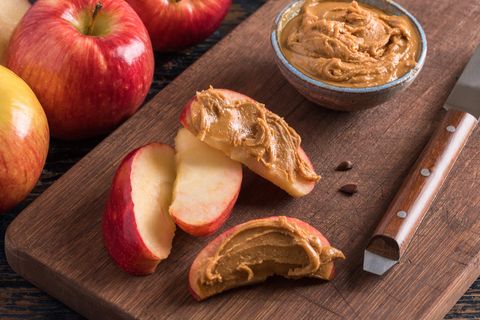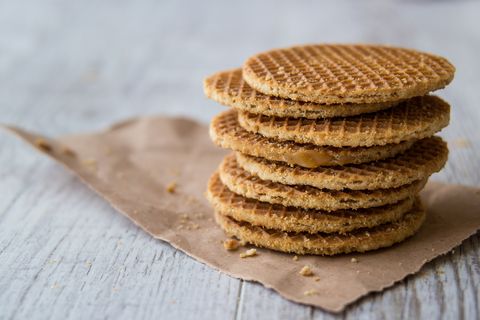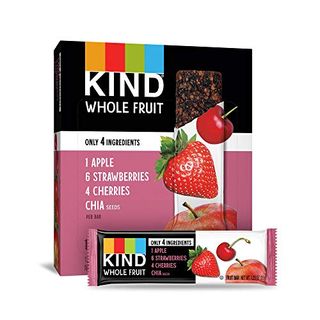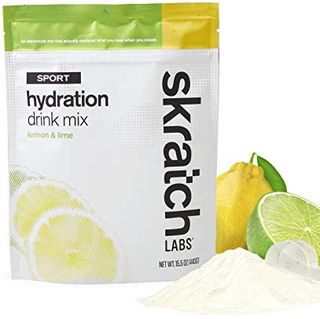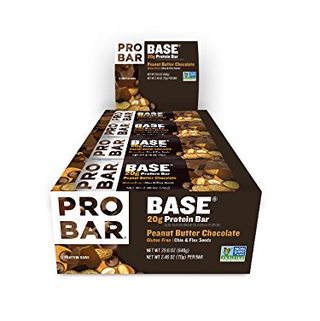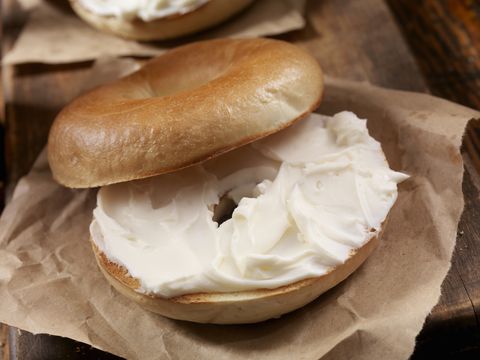In the midst of freezing winter temps, many of us have been churning out our miles on the indoor trainer. With the emergence of smart trainers and virtual races, stay-at-home riding has now become an important training tool for many riders.
Indoor cycling is great for packing a lot of effective training into a short period of time without the need to brave the elements. Just hop on, warm up, and open the throttle.
Yet, what often gets overlooked is that tailoring your nutrition to these sweaty pain cave sessions. Doing so can not only bolster performance during a virtual group ride but can also facilitate long-lasting training adaptations that will serve you well once your back in the great outdoors.
“While many athletes underperform indoors, keeping your body well-fueled will allow you to gain the competitive edge by working at your body’s full potential,” Marni Sumbal, M.S., R.D., owner of Trimarni Coaching and Nutrition, tells Bicycling.
Yes, there are special nutrition and hydration considerations you should take when riding to nowhere. Here’s how to get ready to sweat up a storm, dial in your ride fueling, and properly recharge afterward to make the most of training in the comforts of your home.
Join Bicycling All Access for more fueling tips!
Before Your Ride
Because many virtual races start with a bang, Sumbal says it’s important to give your digestive system time to process any food so you aren’t pedaling with a meal sloshing around in your stomach.
“Otherwise, a quick rise in heart rate and blood flow can cause GI issues, which can leave you with distressing side-effects such as gas, bloating, nausea, or belching,” she says.
You can accomplish this by giving yourself an easy warm-up period on the bike before going gung-ho and allowing enough time between eating a substantial meal and hopping on the saddle for adequate digestion.
“Plus, you want to give yourself time to hydrate before the session, leaving enough time to go to the bathroom,” adds Sumbal.
You don’t want to start a hard workout feeling full or hungry, so it can be a bit of a balancing act for pre-ride fueling. Eating your last substantial meal about two hours before an indoor training session typically allows for enough digestion time to feel good on the bike. This meal should contain a good balance of carbohydrates, protein, and fats. Just don’t go too crazy with fat and fiber—both can mess with your digestive system. Ultimately, the meal-timing window and what you eat is something that you can individualize based on what feels right with your body. As the saying goes, “follow your gut.”
You can then have a small snack roughly 30 minutes before your ride so you’re mentally alert and not lagging behind the peloton sooner than you’d like. This “helps top off your glycogen stores, ensuring that you have a bit of fuel on board for the later part of the workout,” Sumbal says. “This fuel also serves as a way to give the brain a boost, keeping you motivated and emotionally engaged.”
As a general guideline, Sumbal says to consume at least 100 to 150 calories before a ride that you plan to be about one hour in length. If you plan on riding for around two hours, Sumbal suggests aiming for at least 200 to 300 calories before the ride so you can consistently produce high power, or take in 100 to 150 easily-digestible calories (like a gel or sports drink) halfway through.
“At least 80 percent of the calories in this snack should come from carbs, but not those that are too high in harder-to-digest fiber,” she says.
In other words, reach for things that digest well, especially if your workout is going to involve tough intervals. Options that supply easily-digested carbs that settle well include bananas, rice cakes, apple slices with a smear of peanut butter, a handful of dried fruit, an energy gel, or a bar like KIND Whole Fruit that is lower in protein and fat.
These foods come in handy especially if you’re clipping in early in the morning and the idea of eating a hearty breakfast at 5 a.m. seems aggressive. If you typically don’t have much of an appetite at this time, start small, as it can take a bit of time to get used to eating so early. Then try gradually increasing the amount you’re consuming.
“If you’re using your Zwift or other winter indoor rides as a way to prepare for your upcoming spring and summer races, start experimenting with food combinations that you can then use on race day,” Sumbal advises.
She also stresses the importance of hydrating with 16 to 20 ounces of water in the 90 minutes before a ride. “Going into a ride well hydrated will also help with digestion before the workout.”
During Your Ride
Your fueling strategy during an indoor ride should be similar to what you would eat for an outdoor ride, according to Sumbal. Due to the nature of riding on a trainer, you don’t get situations like a tailwind or downhill glide that offer an opportunity to recover and lower your caloric and hydration needs.
“I find that instead of having a plan, many riders haphazardly fuel their indoor ride sessions.” Read: Most people skimp on on-the-bike calories when indoors. (Sumbal says this is because people likely worry less about bonking when they are in the safety of their own home instead of miles away from their fridge.)
This content is imported from embed-name. You may be able to find the same content in another format, or you may be able to find more information, at their web site.
With that said, how you fuel you’re stationary ride all depends on your personal goals. As long as you’ve nailed your pre-ride fuel, any workout lasting less than 60 minutes should not require anything beyond a water bottle. This was played out in a recent study published in the journal Nutrients, which found male and female cyclists did not experience any improvements in power output during short-duration sprint efforts when they consumed a carb-drink compared to a carb-free drink. And, sucking back gels during shorter HIIT-style workouts where digestion rates are even slower could bring on GI pushback. However, Sumbal suggests keeping a sports drink containing 100 to 150 calories with you on any trainer ride just in case you need a little boost.
More prolonged sweat sessions require a greater need for fuel, since your blood sugar and glycogen stores are stressed, and supplementation is needed to help maintain the rate at which your body breaks down carbs. And, when it comes to high-intensity Zwifting of 90 minutes or more, carbs are king. Of the three macronutrients—carbohydrates, protein, and fat—carbs are the ones that provide immediate, more oxygen-efficient energy. But our finite carbohydrate stores (roughly 500 grams total) can sustain high-intensity endurance exercise for only about 90 minutes, after which, race pace begins to slow. So cyclists should prioritize carbs during long-haul indoor rides or risk pulling up the rear.
“Just because you are riding indoors, this doesn’t mean that you need fewer calories than if riding outside,” Sumbal says.
And don’t think your pre-ride meal or snack is going to suffice. An investigation in the Scandinavian Journal of Medicine and Science in Sports showed that people performed better during a six-mile cycling time trial following a 105-minute steady-state effort when they consumed simple carbohydrates every 15 minutes regardless of whether they consumed breakfast beforehand or not.
Sport nutrition guidelines typically recommend consuming between 30 and 60 grams of carbohydrates (120 to 240 calories) for each hour of activity. But the dose that works for you can vary based on several factors including body weight, intensity of effort, and overall fitness. Some athletes have trained their bodies to be able to handle upwards of 90 grams of carbs.
“Because you are not battling environmental conditions like wind and humidity, you may need to experiment with food quantity,” Sumbal says.
A good rule of thumb is to play around with how much food you take in on a few long rides to suss out what keeps you pedaling strong. And, keep in mind that males typically rely more heavily on burning carbs during exercise than females, and, therefore, may benefit from higher intakes.
“Sports drinks can be the most efficient way to digest and absorb calories,” says Sumbal. “It may be too difficult to consume gels, chews, or solid food during high-intensity efforts.”
Sports drinks like Skratch Labs and Liquid I.V. will have varying carb (and electrolyte) levels, so do your label reading. If your workout includes periods when the pace eases, you could try supplementing a sports drink with some chews, a gel, or even something closer to real food, like dried fruit or a packaged stroopwafel. Just remember that you’ll need to chase these with water to facilitate better digestion so their carbs get into your system faster. As with everything related to nutrition, there is a lot of variability between what works best for individuals and their guts.
But Zwifters shouldn’t wait until approaching the red zone to start taking in calories. Research (like this study and this study) shows that early and frequent fueling is better for endurance-extending purposes than taking in a bigger dose of carbs later on during a workout.
“If you feel a bonk coming on, you waited too long to fuel,” Sumbal says.
As for that pool of salty sweat that has accumulated under your bike, “most people will sweat a lot more indoors than outside, so don’t underestimate your hydration needs,” Sumbal says.
Without the wind to naturally cool you, dehydration can be brought on by an indoor sweaty sufferfest and can lead to alterations in physiological function, including impaired muscular contraction and reduced muscle blood flow. This can result in decreased athletic performance, even when you aren’t particularly thirsty.
Dehydration may also delay recovery. Some evidence suggests lack of hydration may exacerbate exercise-induced muscle damage and, in turn, prolong recovery.
Sumbal stresses that you should drink frequently and consistently—every 10 to 15 minutes. “Aim to drink at least 24 to 32 ounces of fluid and 240 milligrams of sodium per hour of a ride.”
After Your Ride
Your nutrition needs don’t cease once the kudos start rolling in. The ability to train day after day depends in large part on adequate recovery which includes nutrition.
Post-ride recovery should combine carbohydrates to replenish spent glycogen stores, high-quality protein to rebuild muscle, and, of course, fluids to rehydrate.
“If the workout was low intensity and/or of short duration, consuming a regular meal within an hour or so will be just fine to promote recovery,” Sumbal says.
But if you really pushed the pace or were pounding out the virtual miles for the long haul, it’s a good idea to nourish yourself shortly after the cooldown before you get a proper meal in your system. A bowl of yogurt and granola, a bar with both carbs and protein (like Probar Protein), a bagel with a generous smear of cream cheese, or a smoothie can get the job done.
“After an intense or long session, appetite may be low, so a beverage [like a protein shake] containing 15 to 20 grams of protein and 30 to 50 grams of carbs can be helpful for getting the recovery nutrition you need,” Sumbal says. “Then, when ready, consume a real meal.”
To alleviate a “what can I eat?” scenario after your ride, consider making your food or blender drink ahead of time so it’s ready to go when you hop off the bike. That way, you’re not rummaging through the pantry or fridge fretting about what you should eat. And if you’re feeling weak, cranky, or unfocused a few hours following a training session, you may simply have not eaten enough afterward.
This content is created and maintained by a third party, and imported onto this page to help users provide their email addresses. You may be able to find more information about this and similar content at piano.io

